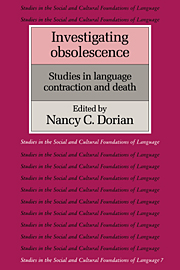Book contents
- Frontmatter
- Contents
- List of maps
- List of contributors
- Preface
- Map
- Dedication
- Introduction
- I Focus on context
- 1 On language death in eastern Africa
- 2 The disappearance of the Ugong in Thailand
- 3 Scottish and Irish Gaelic: The giant's bed-fellows
- 4 The rise and fall of an immigrant language: Norwegian in America
- 5 Breton vs. French: Language and the opposition of political, economic, social, and cultural values
- 6 “Persistence” or “tip” in Egyptian Nubian
- 7 Sociolinguistic creativity: Cape Breton Gaelic's linguistic “tip”
- 8 Skewed performance and full performance in language obsolescence: The case of an Albanian variety
- 9 On the social meaning of linguistic variability in language death situations: Variation in Newfoundland French
- 10 The social functions of relativization in obsolescent and non-obsolescent languages
- II Focus on structure
- III Invited commentaries
- Bibliography
- Index of languages
- General index
4 - The rise and fall of an immigrant language: Norwegian in America
Published online by Cambridge University Press: 08 January 2010
- Frontmatter
- Contents
- List of maps
- List of contributors
- Preface
- Map
- Dedication
- Introduction
- I Focus on context
- 1 On language death in eastern Africa
- 2 The disappearance of the Ugong in Thailand
- 3 Scottish and Irish Gaelic: The giant's bed-fellows
- 4 The rise and fall of an immigrant language: Norwegian in America
- 5 Breton vs. French: Language and the opposition of political, economic, social, and cultural values
- 6 “Persistence” or “tip” in Egyptian Nubian
- 7 Sociolinguistic creativity: Cape Breton Gaelic's linguistic “tip”
- 8 Skewed performance and full performance in language obsolescence: The case of an Albanian variety
- 9 On the social meaning of linguistic variability in language death situations: Variation in Newfoundland French
- 10 The social functions of relativization in obsolescent and non-obsolescent languages
- II Focus on structure
- III Invited commentaries
- Bibliography
- Index of languages
- General index
Summary
In my study of the Norwegian language in America (Haugen 1953 [1969]) I surveyed the language usages of Norwegian immigrants in the United States from the beginnings of immigration in 1825 to the 1950s. I devoted two chapters (10 and 11) to the use and gradual disuse of the language over the more than a century in which it played a significant role in American life. I entitled the first chapter “The struggle over Norwegian” and the second “The triumph of English”. In the present article I shall (1) briefly summarize my findings in the book for the benefit of readers who may not be familiar with it; (2) present some personal data gathered in my fieldwork; and (3) provide a short account of what has happened in the intervening quarter of a century.
Norwegian America: the rise
My point of departure is an 1898 quotation from an eminent Norwegian-American educator: “Now the question no longer is: how shall we learn English so that we may share in the social life of America and partake of her benefits; the great question is: how can we preserve the language of our ancestors here in a strange environment and pass on to our descendants the treasures it contains? (Bothne 1898:828; cit. Haugen 1953:238). It is significant that this question was posed at the turn of the century. By that time Norwegians had been pouring into America for two generations, settling for the most part in the upper Midwest, from Illinois to North Dakota.
More than a half-million Norwegians had changed countries in these years, seeking opportunity in the rural Midwest.
- Type
- Chapter
- Information
- Investigating ObsolescenceStudies in Language Contraction and Death, pp. 61 - 74Publisher: Cambridge University PressPrint publication year: 1989
- 7
- Cited by

